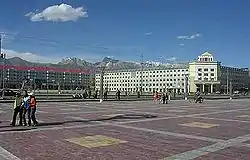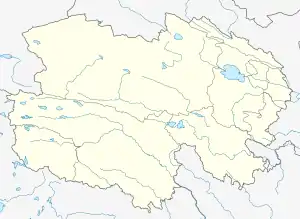Delingha
Delingha (Chinese: 德令哈; pinyin: Délìnghā; Tibetan: གཏེར་ལེན་ཁ།, Wylie: gter-len-kha, ZYPY: Dêrlênka
), or Delhi (SASM/GNC/SRC romanization of Mongolian: ![]() Delhi hot), is the seat of the Haixi Mongol and Tibetan Autonomous Prefecture in northern Qinghai province, China. It is located approximately 200 km (120 mi) southeast of the Da Qaidam Administrative Region. It is a mainly industrial county-level city. The Bayin River divides the city into two parts: Hedong (河东; 'River East') and Hexi (河西; 'River West'). Because the prefecture seat is located in Hedong, it is slightly more flourishing than Hexi, which is chiefly agricultural.[1]
Delhi hot), is the seat of the Haixi Mongol and Tibetan Autonomous Prefecture in northern Qinghai province, China. It is located approximately 200 km (120 mi) southeast of the Da Qaidam Administrative Region. It is a mainly industrial county-level city. The Bayin River divides the city into two parts: Hedong (河东; 'River East') and Hexi (河西; 'River West'). Because the prefecture seat is located in Hedong, it is slightly more flourishing than Hexi, which is chiefly agricultural.[1]
Delhi
德令哈市 · ᠳᠡᠯᠡᠬᠡᠢ ᠬᠣᠲᠠ · གཏེར་ལེན་ཁ་གྲོང་ཁྱེར། | |
|---|---|
 | |
.png.webp) Location of Delingha City (red) within Haixi Prefecture (yellow) and Qinghai | |
 Delhi Location of the city centre in Qinghai | |
| Coordinates (Delingha municipal government): 37°22′12″N 97°21′41″E | |
| Country | People's Republic of China |
| Province | Qinghai |
| Prefecture | Haixi |
| Area | |
| • Total | 27,700 km2 (10,700 sq mi) |
| Elevation | 2,982 m (9,783 ft) |
| Population (2010)[1] | |
| • Total | 78,184 |
| Time zone | UTC+8 (China Standard) |
| Postal code | 817000 |
| Area code(s) | 0977 |
Established in 1988, Delingha administers seven township-level divisions covering an area of 27,700 km2 (10,700 sq mi) and has a total population of 78,184, making it the smallest of the five cities in Qinghai. The name of the city comes from Mongolian and means "golden world" ᠠᠯᠲᠠᠨ ᠳᠡᠯᠡᠬᠡᠢ,[1] reflecting the relatively large Mongol population of the city. Da Qaidam administrative zone merged into Delingha in mid-2018.
Geography
Climate
Delingha has a cold arid climate (Köppen BWk), that borders on a semi-arid climate (Köppen BSk).
| Climate data for Delingha | |||||||||||||
|---|---|---|---|---|---|---|---|---|---|---|---|---|---|
| Month | Jan | Feb | Mar | Apr | May | Jun | Jul | Aug | Sep | Oct | Nov | Dec | Year |
| Average high °C (°F) | −3.7 (25.3) |
0.7 (33.3) |
6.7 (44.1) |
12.9 (55.2) |
17.8 (64.0) |
20.7 (69.3) |
23.1 (73.6) |
23.0 (73.4) |
18.3 (64.9) |
11.5 (52.7) |
3.7 (38.7) |
−1.6 (29.1) |
11.1 (52.0) |
| Daily mean °C (°F) | −10.9 (12.4) |
−6.6 (20.1) |
−0.5 (31.1) |
5.6 (42.1) |
11.0 (51.8) |
14.2 (57.6) |
16.5 (61.7) |
16.1 (61.0) |
11.2 (52.2) |
3.9 (39.0) |
−3.8 (25.2) |
−9.2 (15.4) |
4.0 (39.1) |
| Average low °C (°F) | −16.8 (1.8) |
−12.8 (9.0) |
−7.0 (19.4) |
−1.2 (29.8) |
4.5 (40.1) |
8.2 (46.8) |
10.7 (51.3) |
10.2 (50.4) |
5.2 (41.4) |
−2.0 (28.4) |
−9.4 (15.1) |
−14.9 (5.2) |
−2.1 (28.2) |
| Average precipitation mm (inches) | 4.0 (0.16) |
2.9 (0.11) |
4.6 (0.18) |
6.5 (0.26) |
21.2 (0.83) |
38.4 (1.51) |
40.9 (1.61) |
31.4 (1.24) |
17.6 (0.69) |
6.4 (0.25) |
1.2 (0.05) |
2.4 (0.09) |
177.5 (6.98) |
| Source: Weather China | |||||||||||||
Transportation
The Delingha Airport and Delingha railway station serve the city.
Economy and industry
Delingha will be home to a 400 million yuan "Mars village" used by the Chinese Academy of Sciences to plan future Mars explorations missions.[2]
At an altitude of 3,000 meters (9,800 ft), a 50 MW concentrated solar power plant with parabolic trough opened in 2018.[3]
References
- 德令哈概况 (in Chinese). Xinhua.net. Retrieved 8 December 2011.
- Chen, Laurie (7 September 2017). "China's Mars base plan revealed ... and covering 95,000 sq km, there's certainly plenty of space". South China Morning Post. Retrieved 9 September 2017.
- Newsletter 2018, page 7